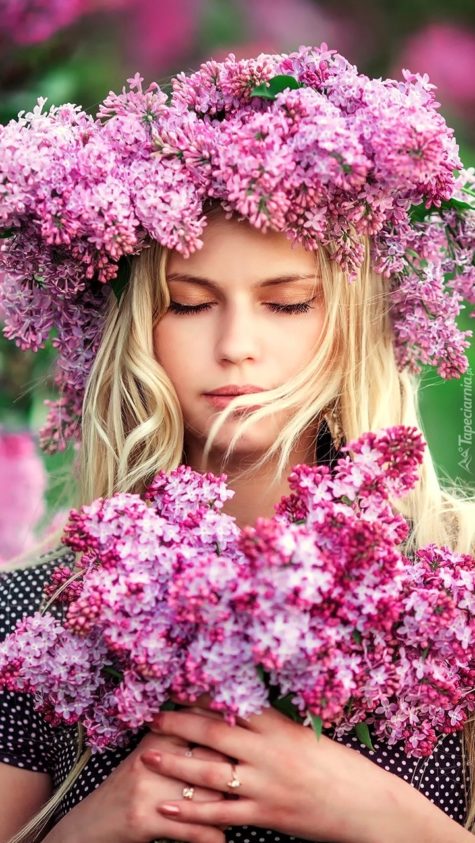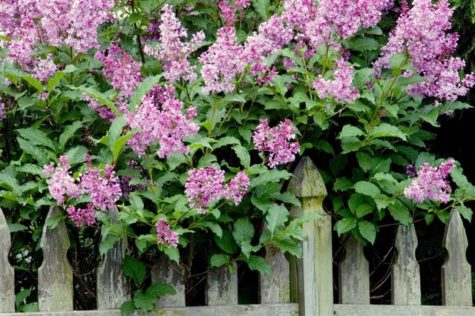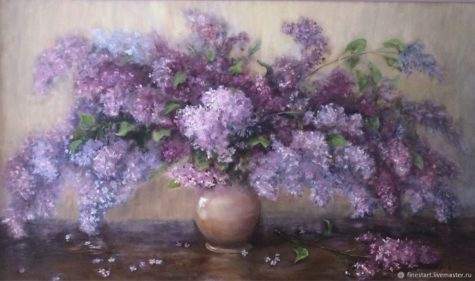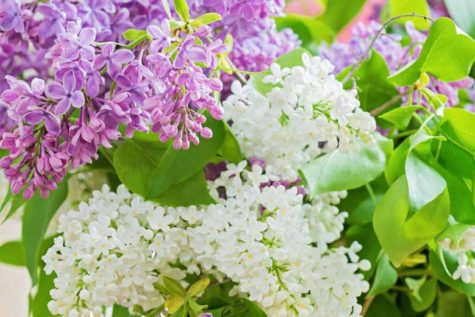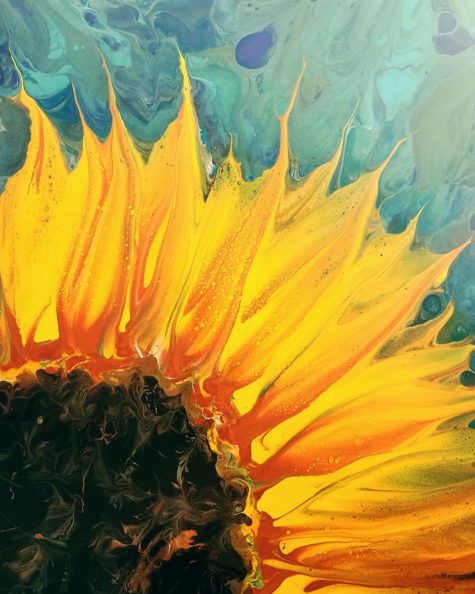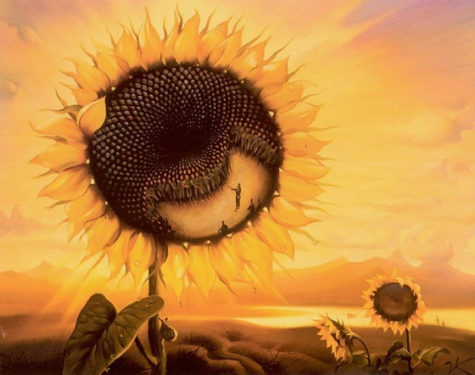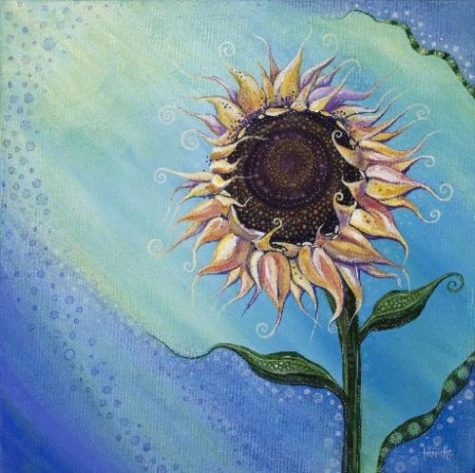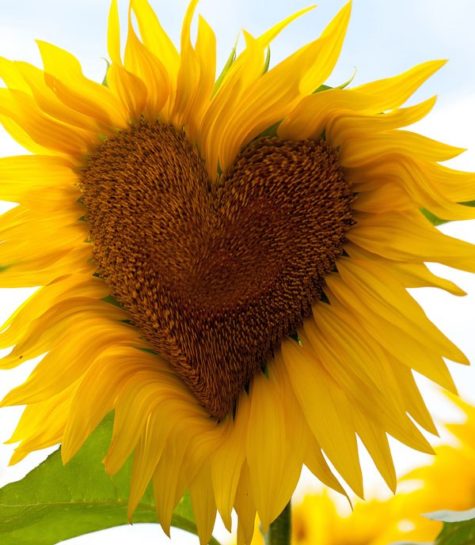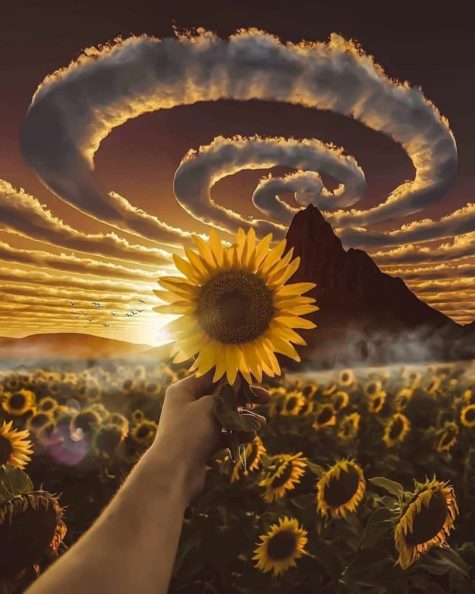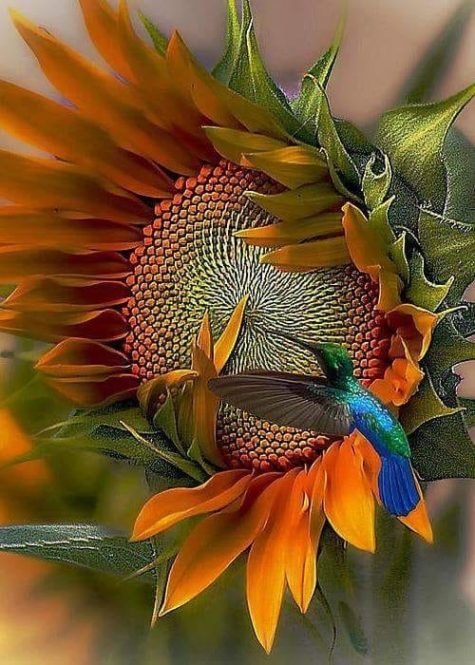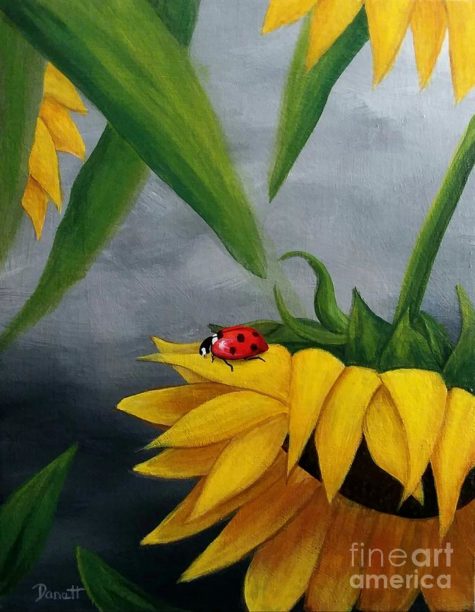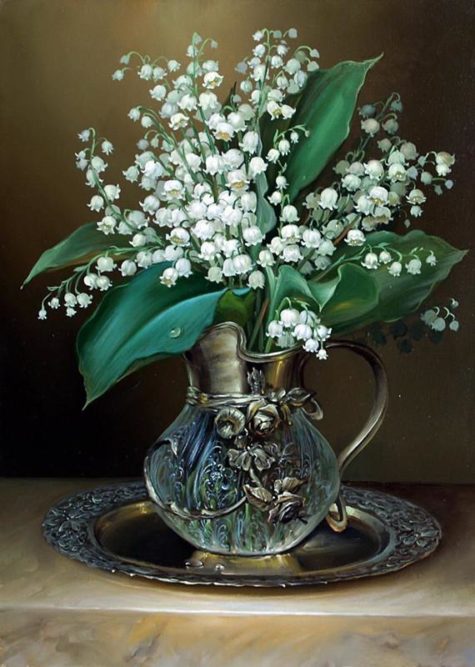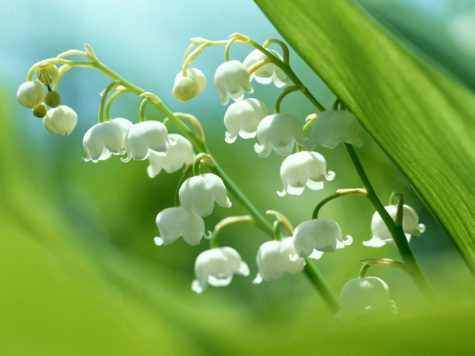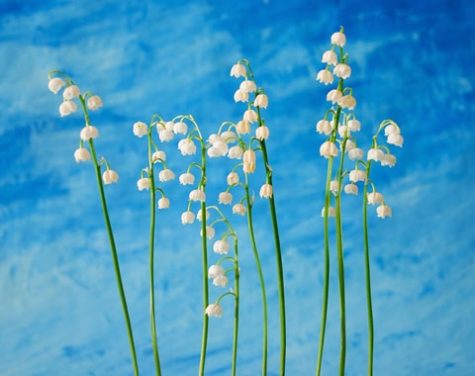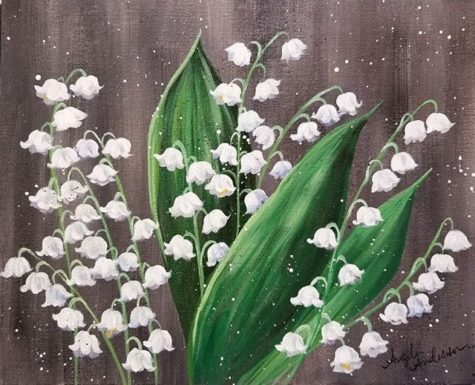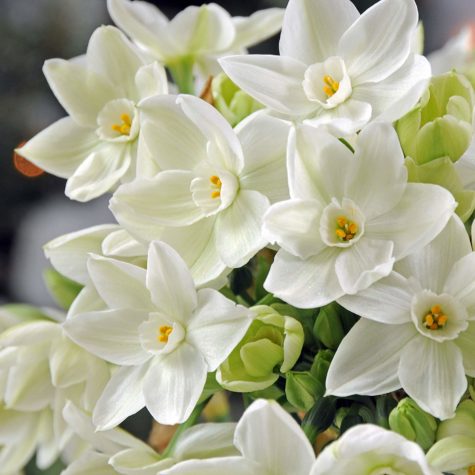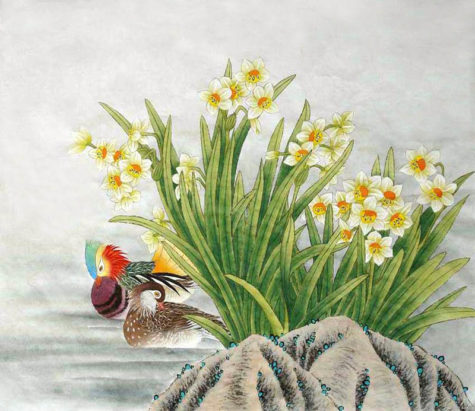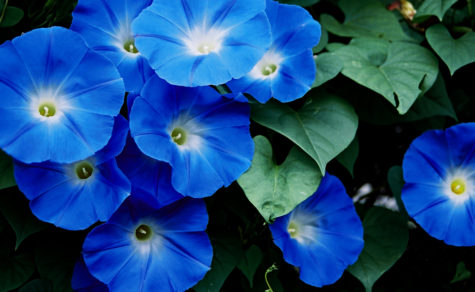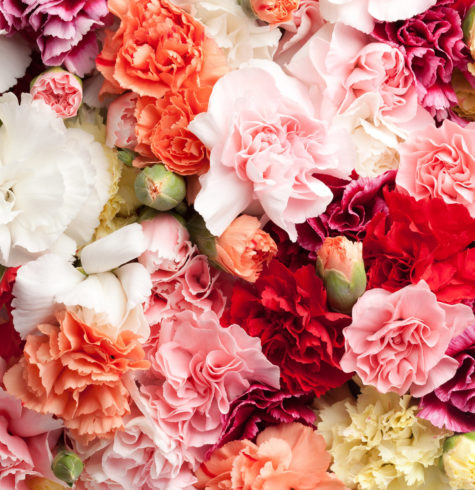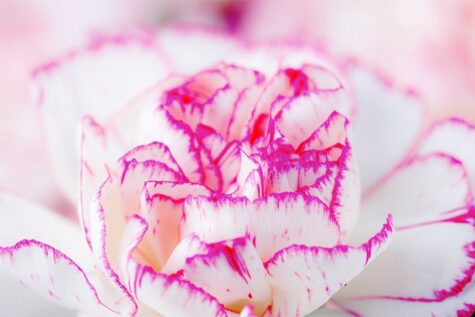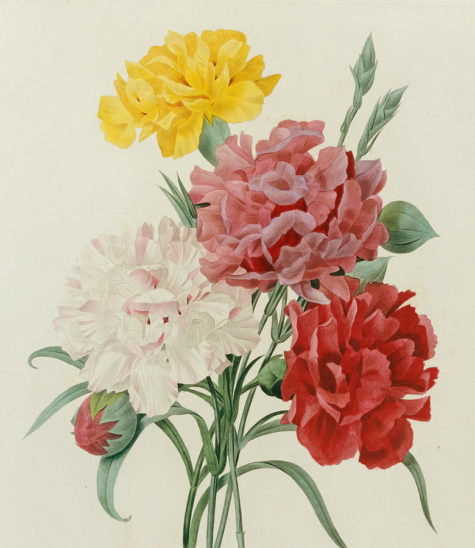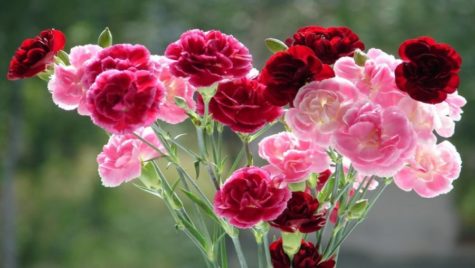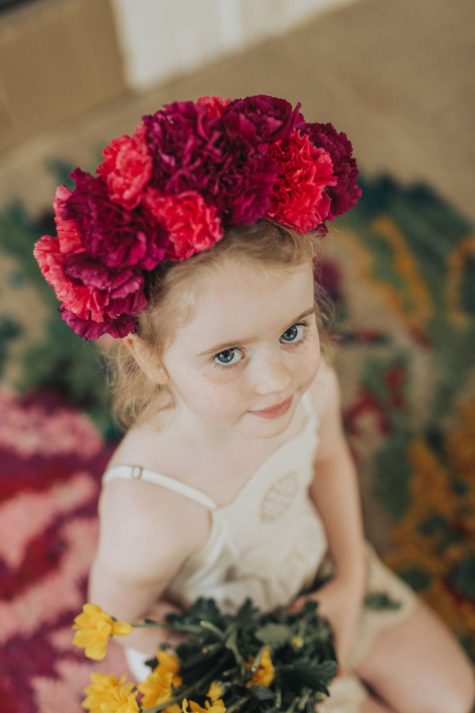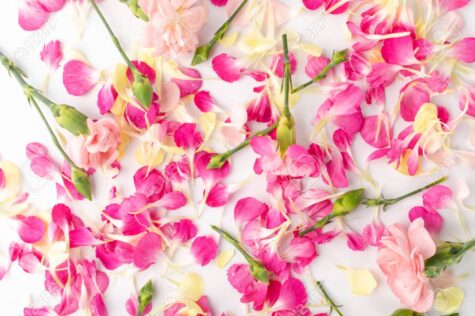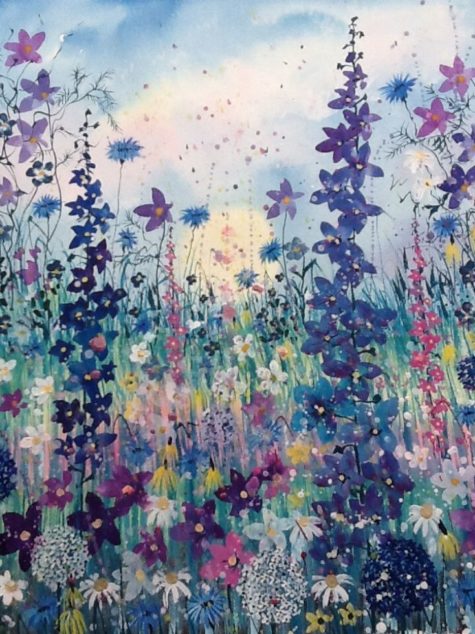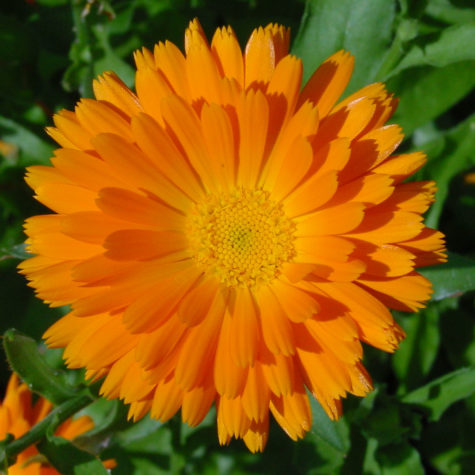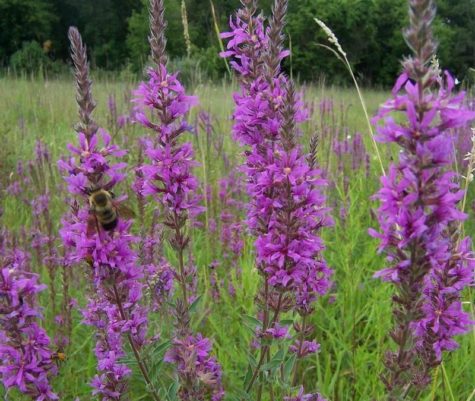Flowers
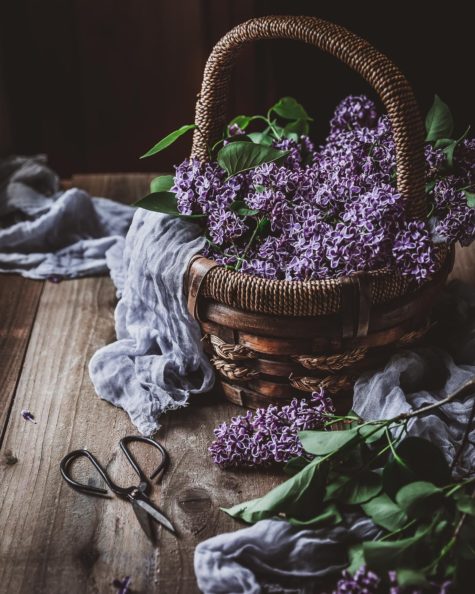
Magickal Uses
- Part used: Fresh flowers
- Planet: Venus
- Element: Earth
- Magickal Influences: Love and Purification
This is the flirt flower. It attracts love quickly although the love it brings often doesn’t last for long. Wear the fragrance or bathe in fresh lilacs when you want a fling. This flower is for fun. It is a great scent to spray in a room before parties or before meeting a date who is taking the relationship too seriously. Lilac keeps things light.
Inhale the aroma rising from the light purple flowers for internal purification. To cleanse a home, place jars of the fresh flowers in several rooms. Bathe in Lilac dew on May Day for a year of beauty.
The scent of fresh lilac flowers was once thought to drive away ghosts.
The scent of lilacs enhances a child’s educational aptitude. Here are a number of ways to use it:
- Place a drop of lilac fragrance oil on a light bulb near where a child studies.
- Place a vase of fresh lilac blossoms on the child’s desk so that the fragrance wafts over the child while studying.
- Place a table and chair outside next to a lilac bush in bloom and send the child outside to study.
Like many flowers, lilacs can be utilized in love expansion rituals. The sweet fragrance of these seasonal blooms brims with loving energies.
In aromatherapy the fragrance of Lilacs is recommended to patients who suffer from chronic depression and anxiety. Lilac blossoms can be added to your bath for a soothing aromatherapy remedy for stress and anxiety.
No true lilac essential oil is currently available, however lilac scents are available. They are said to bring peace and harmony. Also believed to induce “Far Memory” or the ability to remember past lives. It is also useful for inducing clairvoyant powers in general.
Lilac oil reputedly repels vampires and is certainly more fragrant than garlic. Most of the Lilac oil that is commercially available is synthetic; presumably vampires can tell the difference. If you make your own, the lingering aroma should keep the vampire out of the house as well.
A recipe for how to make your own lilac oil can be found here: Oil of Lilac
Jennifer Shepherd at the Lipstick Mystic recommends using the seasonal qualities of lilacs as a way of jump-starting your life. She says,
“Since lilac tends to be one of the earlier flowering plants each spring-time, it carries with it some of the same spiritual energies of other “early bloomers” like daffodils and forsythia. Lilac has the same quality of being able to push or penetrate through harsh, heavy “winter” energies.
So if you’re seeking some kind of significant breakthrough in your life, and you want a little extra kick or punch to help get you through, connecting with the energies of lilac can be very helpful. Smelling the fresh flowers on the bush or bringing a few blooms inside to enjoy is the best way to connect with this special plant.”
Lilac blossoms are natural astringents–they dry things out. Place a cup or two of slightly wilted flowers in a jar, and fill with witch hazel. Allow it to steep for a few days, and then strain out the flowers. Use the lilac and witch hazel blend as a facial toner, to keep your skin looking healthy and fresh all summer. Dab a bit on your wrists when you’re getting ready to go out, to attract new love your way.
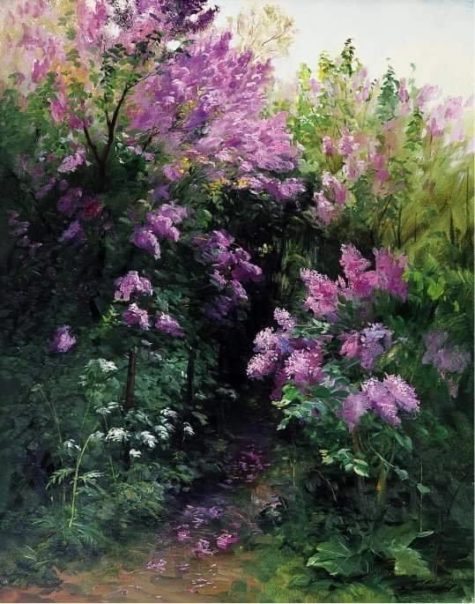
The Lore of Lilacs
The trees were respected by Orthodox Christians and the plant’s Greek name “pashalia” is derived from “pasha” which in Jewish means “passage” as they were considered to drive ghosts away instantly. The lilac tree is also linked with reincarnation.
One of the plant’s secrets is that the flowers do not fade under hot water. Lilacs are said to remove ghosts, aid the exploration of past lives, and bless the passages of life, both birth and death. Purple lilacs are the symbol for the first emotions of love. If the blossoms are strewn about it is said they can ward off evil.
Lilacs have a history of promoting clairvoyance, divination, peace, harmony and creativity. Lilac tonics were probably first introduced in Henry 8th time. They are called a harbinger of spring. White lilacs are a symbol of innocence.
In some parts of England, it is considered unlucky to bring Lilac, especially white Lilac, into the house. The purple and red varieties are usually less feared, but even they are sometimes excluded from house decorations as bringers of misfortune.
In the 1960’s, a florist in Oxford England strongly advised a customer not to buy white Lilac for a friend in the hospital on the grounds that many people thought it foretold death if brought indoors. He did not know why this should be so, only that it was quite commonly believed. In fact it is almost certainly due to the widespread association of death and misfortune with “drowsy-scented” flowers, and also with those which are white.
An interesting detail about the Lilac tradition is that it is found only in some English districts, especially in the midland counties, and quite unknown elsewhere.
It is lucky to find a five-petaled lilac blossom of any color. Along the Welsh border, Lilac trees are said to mourn if any of their kind are cut down, and to be flowerless in the following year.
From the Cincinnati Enquirer 1 August 1900, we have this fun little tidbit:
“She who wears the lilac will never wear the wedding ring,” runs the old proverb, and although the scent of the flower is sweet and its tints are fresh and universally becoming it is contraband among the village maidens in England.
A single boutonniere of lilac has been held responsible for solitary spinsterhood. For the same reason mothers with marriageable daughters never allow a jug of the sweet smelling blossoms inside the house. It may stand on the outside window sill, but “there’s no love luck about the house” when there are lilacs in it.
To give one’s sweetheart a spring of the flower is the death blow to the most secure of engagements. White lilacs are even more fatal to love affairs than the colored ones; they are, in fact, as ominous as an opal ring. Love, however, laughs at artificial flowers, and only the real tree grown one can come between the lover and his lass.
Stony-hearted bachelors sometimes sport a lilac boutonniere as a charm against feminine blandishments. Londoners do not share the superstition, and use the flower freely for decoration, regardless of the unlucky attributes.
Queen Adelaide, consort of King William IV, was apparently unafraid of lilacs, although, to be fair, she was already married when she commissioned her famous Honiton lace dress whose flower patterns, included lilacs, spelled out her name.
The meaning of the lilac flower has diversified throughout the ages. Lilacs originated in Southeastern Europe and are a popular part of the Mediterranean culture. They are frequently associated with the Easter holiday, which occurs during the peak of its bloom time.
Lilac meanings vary throughout different cultures and time periods.
- The Celtics regarded the lilac as “magical” due to their incredibly intoxicating fragrance.
- During the Victorian Age, the giving of a lilac was meant to be a reminder of an old love. In fact, widows were often seen wearing lilacs during this period.
- In Russia, holding a sprig of lilac over the newborn would bring wisdom.
- In the United States, the lilac is the official state flower of New Hampshire and represents the ‘hardy’ nature of its people.
Because lilacs have one of the earliest bloom times, they symbolize spring and renewal. Lilacs also symbolize confidence, which makes them a traditionally popular gift for graduates. There are many meanings that lilacs have that can best be classified by color.
- White lilacs symbolize purity and innocence.
- Violet lilacs symbolize spirituality.
- Blue lilacs symbolize happiness and tranquility.
- Magenta lilacs symbolize love and passion.
Lilac, the color for which this flower is named, is a light purple that symbolizes a first love.
Although various colors of lilacs have different meanings, the lilac has always had a strong association with love and romance throughout history.
Dreaming About Lilacs
Lilac in a dream is a sign of future changes in personal life, the anticipation of big feelings and an exciting love affair.
- White lilac personifies purity, sincerity, sensuality, the birth of affection.
- Violet lilac is a longing for love experiences, yearning of the heart; awakening of romance.
To dream of a blooming lilac is a sign of positive emotions, receiving pleasant news or surprise.
Standing under lilac bush in a dream promises a person a frivolous sexual adventure, which will very quickly exhaust itself, and feelings will evaporate before they turn into something serious.
Miller’s dreambook positioned dreams about lilac mainly as a good sign, foreshadowing love experiences, romance, a surge of sensuality. Flowering lilac shrub reflects the kind and open attitude of people around them to the dreamer, trust and sympathy. Tearing lilac shows a greater likelihood to achieve the desired.
A bouquet of lilac is a sign showing opportunity to find something new about your beloved person, to have sincere conversation. The image promises a romantic acquaintance for single people, but this union will not be long-lasting.
For people who have been married for a long time, a bunch of lilac flowers speaks about the revival of long-forgotten romantic feelings between spouses – sexual desire will be restored and a seemingly past, withering passion will appear.
Some dreambooks interpret ambiguously dreams of a lilac branch. To see a torn off branch in a dream is a symbol of illusion, deceptive hopes that will never be realized. One should beware of strangers who sincerely offer friendship at first glance. To see the blossoming branch of a lilac bush from a window in a dream promises pleasant pastime and an unexpected gift.
To see lilac in a dream and feel its scent means an extraordinary, almost mystical attraction to a person of the opposite sex. Dream interpretation advises not to succumb to this feeling (which will be very difficult to do), because the fruits of such intrigues will remind of themselves more than once, and can easily ruin the life of even the most self-confident person.
If the dreamer happened to pick the fragrant lilac in a dream, it means he will attract close attention of a person whom he likes for a long time.
To dream of a lilac flowers represents feelings about how beautiful it is to notice never fearing a sense of accomplishment in something that isn’t dependent on anything else. A sense of accomplishment in something that nobody else wants to do that always cares about your feelings. Feeling good noticing yourself successful from being self taught. Feeling good about your children having grown up to be independent never needing you for anything.
Sources:
- Encyclopedia of Herbology
- Mrs Daffodil Digresses
- Magical Aromatherapy
- The Encyclopedia of Superstitions
- Encyclopedia of Magickal Ingredients
- Magical Herbalism
- Element Encyclopedia of 5000 Spells
- FTD by Design
- Check My Dream
- Scientific Name: Helianthus annuus
- Type: Plant
- Quality: Hot
- Planet : Sun
- Element: Fire
- Parts Used: Seed, Flowers, Whole Plant
- Basic Powers: Protection, Fertility
When summer is at its peak, its not uncommon to see rows of sunflowers blooming in all of their colorful glory. Ranging from just a foot or two high to well over eight feet in height, sunflowers come in a variety of yellows and oranges. Sunflowers have been growing in North America for ages, so there is a significant amount of folklore surrounding them.
No flower can lift someone’s spirits quite like sunflowers. They are bright and cheery, and as warm and inviting as the sweet summer sun. With brilliant yellow petals, also known as “rays,” sunflowers have an unmistakable sun-like appearance.
As its name signifies, the sunflower has close solar associations, not only because of its appearance, but also because of its habit of turning its head to follow the course of the Sun during its journey across the sky.
Spirits of the dead are drawn to this flower, for it reminds them of the sunlit world they once lived within.
The sunflower has magickal powers, too, and adorned the crowns of Roman emperors, thereby conferring the ruler with the potent power of the Sun that the flower held within it. The sunflower was later adopted by the Christian Church to denote the saints, prophets, and apostles of the faith; as the flower follows the Sun, so the true believer follows God.
Sunflower Lore
The sunflower originated in South and Central America, and migrated north, most likely due to the migration of Spanish conquistadors. Remains of sunflowers dating back 4,600 years have been found in Mexico. In the 1500s, Spanish explorers took sunflowers back to Europe with them, and the species has spread around the world since then.
In the 16th century, Inca priestesses in Peru worshiped a giant variety of the sunflower plant. This plant was a symbol of the Inca sun god.
The Inca priestesses wore clothing that was adorned with large flower shaped ornaments. These ornaments and decorations were made from gold, and the image of the sunflower was often carved into golden breastplates.
The sunflower was sacred to Native Americans; the flowers were used extensively in celebrations and festivities.
Native Americans used this plant for food and other things. It is believed that it was a very important Native American crop. Like the Inca priestesses that came before them, Native Americans also worshiped the plant.
They held spiritual ceremonies such as the Sun Dance. As well as being a food source, the flower became a symbol of strength and endurance. They would put sunflower seeds on top of graves containing their dead.
Early colonists in North America learned about the many uses of sunflowers from the tribes near them. In addition to being useful as a source of yellow and orange dye for fabric, the sunflower also comes in handy medicinally – it was known for its antimalarial properties.
Sunflowers In Legend
The Greek legend had it that a nymph called Clytie and the Sun God, Helios, were in love. But Helios cast aside poor Clytie for another lover. Clytie died of grief and was transformed into the sunflower, destined to live alone and having to follow the course of her former love. Therefore the sunflower, as a symbol has adopted an aspect of Clytie’s personality: the inability to overcome the emotions or to “let go.”
- An alternative story is as follows:
There was a maiden who fell in love with Apollo. Every time he passed overhead in his fiery sun chariot, she stood in her garden and gazed at him longingly, even though she had chores and tasks to attend to. Apollo, who made a point of shining brightly so people on earth couldn’t actually see him, eventually got fed up with the girl’s foolishness. He flung one of his sun arrows at her, and she turned into a sunflower on the spot.
To this day, she faces east in the morning and west in the evenings, following the path of Apollo. In some versions of the story, it was not Apollo but the other gods who took pity upon her and turned her into a sunflower.
Sunflower Symbolism
The sunflower is a symbol of light, hope, and innocence, and has been adopted fairly recently as a symbol for world peace.
Sunflowers are known for being “happy” flowers, making them the perfect gift to bring joy to someone’s (or your) day.
In many folkloric traditions, sunflowers are seen as symbols of good luck. Sunflowers are often associated with truth, loyalty, and honesty.
The seed head of the sunflower contains a magical symbol. It shows a perfect example of the golden spiral that has been created naturally. This shape is one of the cornerstones of sacred geometry.
The Victorian language of flowers gave it various connotations, so that in certain contexts it stood for lofty ideas, or less flatteringly as a symbol for false riches.
In China, this flower symbolizes longevity or long life. It may be due to the sun which is perceived to have an enduring life even though eventually it will die out.
On a practical note, when these plant stems are cut to make flowers for vases and bouquets, they can last for 2-3 weeks so are quite hardy.
In dreams, the sunflower is believed to be a very lucky symbol or motif. It is viewed as symbolizing career and employment ambitions, wealth, good fortune and positive opportunities.
This flower is quite the lucky charm for someone who may be beginning on a new career path or starting a job.
One of the sunflower’s greatest and most important symbolic meanings is that of having a nuclear-free world. This flower was chosen back in 1996 in order to represent a world of peace and one that is free of any harmful nuclear weapons.
New varieties and seeds were planted during this time on an old Ukrainian missile base and also planted across nuclear disaster sites such as Fukushima, Chernobyl and Hiroshima.
The flowers have been shown to absorb harmful toxic elements and radiation from the soil and clean up the environment. Being so good for the environment as well as beautiful to look at, it is no wonder that the sunflower has now truly become a symbol of peace and also hope for the future of humankind.
Magickal Uses:
Faery flower sorcery sees the sunflower as harnessing the energy of the sun itself, making it useful for positive magick and lightwork. The light contained in its yellow petals radiates strength, useful for dispelling depression and encouraging a healthy sense of pride.
The flowers growing in the garden bring the blessings of the Sun. The seeds are often eaten by women who wish to conceive. This is done during the waxing Moon.
Always include a sunflower or sunflower seeds in a birthday spell to increase happiness, health, and years. Sprinkle the seeds on the earth to invoke prosperity. Place the flowers on a love altar to invoke a long-lasting relationship.
Sunflowers are symbols of good luck. Planting them around your home and garden will bring fortune your way. It is also said that if you pick a sunflower at sunset, then wear it on your person, it will bring you good luck the following day.
Sunflower seeds that dry and remain on the flower head are said to possess the magickal capacity to grant wishes. Hold an individual seed in your left hand and make your wish. Eat the seed or plant it in Earth.
Sunflowers are also associated with truth, loyalty, and honesty. If you want to know the truth about something, sleep with a sunflower under your pillow – and the next day, before the sun goes down, the truth should be revealed to you.
To reveal a thief, place three sunflowers under your pillow. The thief will be revealed in your dreams.
The sunflower is considered a flower of loyalty because day after day, it follows the sun, from east to west. In some folk magic traditions, it is believed that slipping a bit of sunflower oil or seeds into someone’s food or drink will cause them to be loyal to you.
The sunflower is often associated with fertility, thanks to its connection to the sun. To bring about conception, eat sunflower seeds or take a ritual bath with sunflower petals. A necklace or crown of dried sunflower heads can be worn–particularly at Litha, the summer solstice–to bring about fertility.
In 17th Century Europe, some rural practitioners of folk magic used an ointment that would help them see the Faerie folk. This used a blend of several summer, sun-oriented flowers, mixed in with sunflower oil and left in the sun for three days until it thickened.
Some people believed that sunflower seeds were preventatives against the spread of smallpox. Weave and knot dried sunflowers into necklaces and wear them to magickally repel smallpox.
In some forms of Hoodoo, the sunflower is associated with great joy. The oil is often used as a base in magical oils for ritual purposes. You can blend your own magical sunflower oil by blending freshly harvested petals into a carrier or base of sunflower seed oil, which is available in most grocery stores.
Please note that this is not the traditional hoodoo sunflower oil recipe, but it is still one that is effective. Once you’ve mixed your oil, consecrate it according to the method of your own magical tradition before using it in spellwork or ritual. A simple way to do this, with sunflower oil, is to leave it in the sun to absorb solar energy prior to use.
Brew a tea of sunflower petals in water, and use it to asperge around a sacred space during Litha rituals or solar-related spellwork. If you’re grieving or feeling down, use sunflower petals in a ritual bath for a magical, sunny pick-me-up.
The Spiritual Meaning of the Sunflower
The sunflower appears to worship the sun because the blooms have been thought to face the sun as it slowly moves and travels across the sky each day.
Many people view this flower as being highly spiritual. These flowers appear as if they follow the sun as it moves each day from East to West in the sky. It makes the flowers look as if they are highly loyal and devout, just as a follower of faith is.
In a spiritual meaning, these plants are seen as being genuine followers of the sun. This has a connection with Christians following God and other religions following their spiritual guide or divine being.
No matter how small or how little light there is, sunflowers are believed to seek out the light and hold their heads high as if in worship and adoration of the sun.
They are therefore a symbol of true and faithful loyalty to something that is much brighter and bigger than themselves.
Sources:
- Magical Herbalism
- Learn Religions
- Encyclopedia of Magickal Ingredients
- Feri Tradition
- Element Encyclopedia of Secret Signs and Symbols
- Pro Flowers
- Parts Used: Fresh flowers
- Planet: Mercury
- Element: Air
- Magickal Influences: Peace, Conscious Mind, Memory, Attracts Fairies
Convallaria magalis, the botanical name for Lily of the Valley means “that which belongs to May,” making lily of the valley the recognized flower of the month of May, and thus, May birthdays. It is also the official flower of the zodiac sign Gemini.
This plant is also known as Little Maybells, May Bells, Mary’s Tears, Our Lady’s Tears, Jacob’s Ladder, Ladder to Heaven, Jacob’s Tear, May Lily, Convail Lily, Lily Constancy, Muguet, Male Lily, Convallaria, and Fairy Cups.
The well-known and dangerous effects of lily of the valley apply to its internal use, but not to its fragrance. Don’t eat, drink, add to your bath water, or rub into your skin.
Lily of the valley is a fragrant flowering plant used in religious ceremonies, world celebrations, perfumes and in gardens. Also known as the May lily, the name means “return to happiness” and most often symbolizes chastity, purity, happiness, luck and humility. Its meaning and symbolism are represented in Christian lore and folklore, on May Day, weddings and birthdays, and in various celebrations throughout the world.
This tiny plant produces sprays of white, bell-shaped flowers that emit what Culpeper calls a “pleasant, grateful scent.” The aroma instills peace and strengthens the conscious mind. With visualization, the scent will heighten your ability to recall old information and strengthen your powers of memory.
Although the cut flowers are occasionally available in florist shops in springtime, no true lily of the valley essential is available.
This European native plant was first cultivated in 1420 and is beloved by the Fae and humans alike. It is sometimes called Fairy Cups, because the flowers look like cups the fairies have hung up while dancing. The flowers are said to ring when fairies sing and to form ladders fairies use to reach reeds from which they weave their cradles. Obviously, this is a good plant for attracting the Folk to your magickal garden.
According to folklore, this plant blooms on the grave of someone who was executed for a crime they did not commit. It is thought that planting them in the garden will protect the home from ghosts and evil spirits. Although some people consider it bad luck to bring the flowers into the house, in France, people still trade gifts of this plant on May Day in order to have good luck through the year.
The scent of this flower is said to attract nightingales and to give people the power to see a better world.
In the language of flowers, Lily of the Valley means return of happiness, purity of heart, sweetness, tears of the Virgin Mary, you’ve made my life complete, humility, happiness, love’s good fortune. One legend of the lily of the valley is that it sprang from Eve’s tears when she was kicked out of the Garden of Eden.
As a symbol of chastity, purity, modesty and happiness, lily of the valley has been a popular wedding flower since the Middle Ages. According to legend, its strong fragrance lures the nightingale to find his mate. For some brides, the flower is the fifth item carried during a wedding, along with something old, new, borrowed and blue. In Holland, the flower is planted in a newlywed couple’s garden as a symbol of the renewal of love.
Lily of the valley is supposed to protect gardens from evil spirits and is known to have been used as a charm against witches’ spells. It is also considered the flower of fairies, its tiny bells used as cups from which to drink.
Some European countries believe lily of the valley prompts visions of heaven, aiding man to see a brighter future. In Germany and Scandinavia, the flower is a springtime symbol of good luck. In England, when St. Leonard of Sussex fought his grievous great battle with a dragon during the sixth century, as a commemoration to his efforts, the flowers are believed to have sprung from the ground where his blood spilled.
It is also believed that the flower is in honor of Maia, the daughter of the mythological Atlas, the oldest of the Seven Sisters and the goddess of growth, increase, fields, and spring. She and Zeus are the parents of Hermes (Mercury), and so she is the grandmother of magick, which was invented by her son Hermes. The month of May is named for her, and the 1st and 15th of May are her sacred days. Her worship survives as the celebration of the Queen of May in the Catholic church. In the past, only women were allowed to worship Maia. In ancient Rome, May was a time of purification and religious rituals, so it was a very unlucky month to get married (pretty interesting considering that nowadays lilies-of-the-valley are a standard in the bridal bouquet and represent marital longevity).
Lily of the valley is associated with Gemini because of the Mercury (Hermes) connection. Gemini rules divination and summoning, and since Mercury rules magick, this is a good plant to use for ceremonial magick or divination. You could make a great oil for aiding divination by macerating (soaking) the flowers in almond or olive oil. Make a number of macerations in the same oil to get a good buildup of scent. The lily of the valley perfumes commonly available are made from synthetics. Growing the plant is the only way to acquire a natural perfume of the flowers.
On May 1, 1561, King Charles IX received lily of the valley as a gift of luck and continued the tradition every first of May by giving the women of his court this fragrant flower. Today, every year in France, bunches of lily of the valley are sold on streets. In some cities, on May Day, folks wear a sprig in their clothing. The flower is also a symbol used on International Worker’s Day (also known as May Day), or Labor Day as it is known in the United States. The Finnish girl’s name Kielo means lily of the valley. It is also Finland’s national flower.
Considered a Mercury herb, lily of the valley was in the past used for illnesses of the head or brain, such as melancholy, depression, epilepsy, and stroke. Its decoction was mixed with lavender and peppercorns and spread on the forehead and back of the neck to bring someone to their senses. However, later it became much used as a far less poisonous substitution for foxglove and applied to heart disease. Historically, Germans have made a raisin wine with some of the flowers. This demonstrates that although the plant is toxic, the poison is poorly absorbed. The sap can be a skin irritant, however. Leaves of this plant furnish a green dye in spring and yellow in autumn.
The sweet, bee-attracting flowers appear in May; folk belief says plant tomatoes when you see them appear. It makes a great groundcover around shrubs, especially under lilacs (blooms at the same time). This is a good plant for the corners of your house, where nothing else will grow. It produces berries but reproduces mainly through creeping rhizomes.
Information collected from various sources.
- Ruler: Dionysus
- Type: Plant
- Sign: Virgo
- Tarot Card: The Hermit
- Magickal Form: Flower, Essential Oil
The Narcissus is often assigned to the month of December, and is also associated with the Chinese New Year which occurs in February.
Wear this scent to entice others and promote self-love and self-confidence. Overuse can attract stalkers and create egomaniacs – so don’t over do it. Rub on pink candles to meet new people. Rub black Narcissus oil on black candles for self-hypnosis. Use the oil on red candles to hypnotize and bewitch another.
In China, for centuries, narcissus bulbs have been placed in bowls with rocks and water. They are then “forced” into flowering by the Chinese New Year to acquire good fortune.
This old-fashioned flower for late spring is famous for its fragrance, which is one of the most expensive in the world. The Romans made a perfume from this flower, and it featured in early Arab perfume as well. The scent is a combination of jasmine and hyacinth. Its fragrance affects the nervous system (Mercury again), relieving stress.
These beautiful flowers emit sweet, lovely fragrances long used to manifest new relationships or to enrich the love already shared with another. The purple varieties seem to be best for this use. In the Middle East, the scent is thought to be aphrodisiac.
Magickally, this old-fashioned flower is dedicated to virgins, hermits, those who practice a solitary spirituality, and people who just enjoy being alone. Reasonably, it is connected to the sign of Virgo and the Hermit card. Venus bathed in narcissus flowers before winning a contest of beauty against Juno and Diana, but the plant is sacred to Adonis.
You would think then that this magick herb would be associated with the Sun, but instead it is considered a Mercury herb. Its name comes from the word for “stuck dumb” due to the power of its poisons to take away speech, which Mercury rules. Narcissus is specific for Mercury magickal works, such as those leading to parthenogenesis and invisibility.
Narcissus vs Daffodil
Though their botanic name is Narcissus, they are often also called daffodils, and sometimes jonquils, or paper whites. In England, because of their long association with Lent, they’re known as the “Lent Lily.”
The term “Daffodil” commonly refers to Narcissus with large trumpets, but may be used for all types of Narcissus . This is the official common name for ANY of the plants that fall into the genus Narcissus. So, if the plant is considered a Narcissus, it is also considered a daffodil as well. However, most people use the term “daffodil” when referring to the large, trumpet-shaped flowers of the Narcissus pseudoNarcissus .
- In Victorian flower language daffodils signified regard and chivalry, whilst the Narcissus meant self esteem, female ambition or vanity.
You can read more about the magickal properties of the Daffodil here: Daffodil Magick and Lore.
Narcissus in Mythology
The Narcissus is named after the legendary young Greek man of the same name. Narcissus was pretty full of himself because he had been given the gift of great beauty by the gods. One day, a sweet young wood nymph named Echo spotted Narcissus hanging out by a stream and instantly fell in love with him. However, he was so busy being completely self-absorbed that he ignored Echo, and she wasted away from loneliness until nothing was left of her but her voice. Thanks to this tragic story of unrequited love, the Narcissus is sometimes used to represent a love that is one-sided.
Later, the goddess Nemesis, although in some versions, it’s Venus, got wind of what had happened to Echo, so she decided it was time to teach Narcissus a lesson. She led him to a stream, where he happened to notice the most beautiful young man he had ever seen – it was his own reflection, and he was so vain that he fell in love with his own image, transfixed, and forgetting to eat and sleep. Some of the other gods were worried that Narcissus was going to starve to death, so they turned him into a flower, which now blooms every year in the spring.
- Alternatively
It is possible that this plant wasn’t named after the youth who fell in love with his reflection in a pool of water. Pliny states that the name was derived from the word “narkao, to benumb, due to the plant’s dramatic effects on the nervous system when taken internally. Never eat any part of this plant.
- Ruler: Sun, Apollo
- Type: Plant
- Magickal Form: Flowers, Vine, Leaves, Seeds
With it’s lovely flowers, heart shaped leaves, and clinging vine, the morning glory plant is definitely something to consider when constructing a love and/or relationship spell.
Grind morning glory seeds to a fine powder and add to flying incense to gain psychic sight.
In the language of flowers, the morning glory represents affection. As a gift, these beautiful flowers can be given in nearly any way imaginable – from the traditional bouquets to pressed or dried single blossoms. When given as an arrangement, you might also take color into account. That is to say, your message may generally express a feeling of affection, but that affection might be tinted with the fiery passion of a red blossom, the calm of a blue one, or the spirituality of a purple one.
In some cultures the ipomoea aquatica variety of morning glory is considered a delightful green that can be used in a number of dishes. They are frequently placed in salads, stir fries, mixed with noodles, or simply used as a garnish.
Although morning glory seeds are considered to be mildly toxic and have side effects such as hallucinations, nausea and drowsiness, many people still consider them to have powerful medicinal effects. The Aztec narcotic ololiuhqui, derived from a wild morning glory, was spread on surface of affected parts for gout, and the seeds were eaten by the Aztecs to bring visions. Their molecular structure resembles that of LSD. The seeds are sold in nurseries for planting.
- NOTE: Using the seeds as a hallucinogenic is not only illegal but they are harmful when ingested.
In China, the morning glory was once considered a highly effective laxative; to the native Indians of Mexico, both ipomoea tricolor and turbina corymbosa were frequently used in rituals and medicine for their supposed soothing properties.
In folk medicine, the boiled leaves of certain species are used as a diuretic; the seeds are chewed to aid in soothing stomach pains, while the whole plant may be cooked and turned into a topical ointment to treat rheumatoid arthritis. Morning glory tea was said to be good for dysentery and diarrhea.
According to Scott Cunningham (Encyclopedia of Magical Herbs) the morning glory or bindweed (Ipomoea spp) are masculine plants, classified as being under the influence of the planet Saturn; the element water, and with powers over happiness and peace.
Cunningham indicates that one can “Place the seeds beneath the pillow to stop all nightmares.” And also that grown in the garden, blue morning glories bring peace and happiness. The root of the morning glory, according to Cunningham, may be used as a substitute for High John the Conqueror root.
Sources:
- Folkname: Gilliflower, Jove’s Flower, Nelka
- Type: Flower
- Ruler: Capricorn, Saturn
- Planet: Sun
- Element: Fire
- Magickal Form: Fresh, dried, essential oil
- Basic Powers: Protection, Energy, Happiness
Inhaling the gorgeous scent of the carnation flower will immediately enhance emotions of joy and happiness, so the addition of the essential oil is perfect for incenses and oils to dispel depression and disappointment. Brush flowers down your body to cleanse. After reaching the feet, break the stems to trap and hold the negative energy. This flower also helps relieve the depression of winter.
Keep red carnations on the altar to increase your energy level and to create more optimism in life. Once worn by Witches to prevent untimely death on the scaffold, it is used in power incenses and placed on the altar to produce added energy.
Dry nine red carnations in the Sun, crumble them and separate from the stems. Pour one dram carnation essential oil over them, mix well and smolder on charcoal for a tremendously powerful incense. Produces tons of energy!
Used to remove hexes and negative energy, the carnation is especially good for clearing out love problems. Add white and red carnations or essential oil to bathwater to stabilize your love life. Carnation flowers attract abundance as well, either as a bouquet or in a formula.
Including carnations or carnation oil in a blend for the sickroom is perfect to aid in the mental aspects of healing. If your eyes are bothered, rub them with red carnations – it will help. This belief comes from the biblical legend in which carnations sprang up where the Mother of Jesus’s tears fell as she cried over her son’s crucifixion.
Carnations have a history of being brewed into tea to help reduce stress and restore energy. Carnation tea has also been used to reduce fever and treat stomach aches. In addition to tea, carnation oil is used in beauty products to moisturize skin, minimize wrinkles, and treat skin conditions.
Magickal Carnation Aromatherapy
Raised in hothouses stretched along the Pacific coastline and grown across the border in Mexico, Carnations pop up everywhere and are available all year at fairly reasonable prices. The vast majority of these flowers are, however, useless for magickal aromatherapy.
As has been the case with the rose, carnations have been hybridized to produce the biggest bloom size, longest stems and brightest colors. The scent has been forgotten. Thus most carnations obtained from florist shops are virtually scentless. The red ones are an exception, but even here the spiciness is slight.
So what can you do if you wish to utilize the intriguing energies within carnations? Get yourself some starter plants and grow your own. What better way to ensure that you have a steady supply of these fabulous blooms? Look for short-stemmed red varieties with the heaviest fragrances.
These flowers, which Gerard said have an “escellent sweet smell,” are also smelled, with proper visualization, to bring a spicy love into your life.
Before a potentially exhausting magickal act, inhale the rich aroma of fresh carnation flowers. Accept the flower’s energy into yourself. Add it to your physical store of power which will soon be released from the body during magick.
When you’re suffering through a cold or some other minor illness, keep carnations around your sickbed. Inhale their odor while visualizing yourself in a healthy, healed state. If friends wish to give you flowers, you can always ask for carnations – even commercially grown ones.
The Sign of the Carnation
If you were born between December 22 and January 21, you were born under the sign of the Carnation. Those with the carnation flower sign are beautifully adept at putting things in order, and organizing. You are strong willed and determined for others to see your point of view.
You are a natural leader, and others look to you to lean on. You can be driven and determined and this makes you a strong personality. You are no stranger to hard work, and you like to get things done your way. You like security, particularly if you are building a comfort zone with your own two hands.
Carnation Symbolism
- Carnations are the traditional first wedding anniversary flower.
- Carnation is the birth flower for those born in the month of January.
For the most part, carnations express love, fascination, and distinction, though there are many variations dependent on color.
- Green colored carnations are associated with St. Patrick’s Day.
- The pink ones stand for a mother’s eternal love.
- Light red carnations represent admiration.
- Dark red denotes deep love and affection.
- White carnations represent pure love and good luck.
- While striped (variegated) carnations symbolize regret that a love cannot be shared.
- Purple carnations symbolize untrustworthiness.
Carnation symbolism around the world:
- Carnations native to the Near East, symbolize bonds of affection and love, health and energy.
- In Portugal, bright red carnations were used when in 1974 the authoritarian Estado Novo regime was overthrown; therefore, this transition is known as the Carnation Revolution.
- White carnations, in the Netherlands are associated with HRH prince Bernhard. He wore one during World War II and in a gesture of defiance some of the Dutch population took up this gesture. After the war the white carnation became a sign of the Prince, veterans and remembrance of the resistance.
- In France, the purple carnation is a traditional funeral flower, given in condolence for the death of a loved one.
- Along with the red rose, the red carnation can be used as a symbol of socialism and the labor movement, and historically has often been used in demonstrations on International Workers’ Day (May Day).
- According to a popular belief in Russia, white carnations may take away your talent and good luck. Those who want to present a performer on stage with flowers should avoid white carnations. On the other hand, placing a white carnation under the pillow will awake you inspired next morning.
According to a Christian legend, carnations first appeared on Earth as Jesus carried the Cross. The Virgin Mary shed tears at Jesus’ plight, and carnations sprang up from where her tears fell. Thus the pink carnation became the symbol of a mother’s undying love.
Carnation Story and Origins
Carnations are also called pinks because of their spiky petals that look like they were cut with pinking shears. There are several theories about how the carnation got its name. Some believe that it comes from the word coronation because it was used in Greek ceremonial crowns. Others think that it originated from the Latin word carnis, meaning flesh, because early carnations were typically pink.
Carnations scientific name is Dianthus caryophyllus. Some believe the name Dianthus originated from the myth of Diana. There are a few variations of this story. In one variation Diana, goddess of the hunt, was returning from an unsuccessful hunting trip. She stumbled upon a shepherd playing a flute and blamed his music for spoiling her hunting.
In a fit of rage she attacked him and plucked out his eyes. Once she cooled down, she regretted her actions. Where the eyes fell, red carnations grew as signs of innocent blood.
Others believe that Dianthus was named after Zeus, as Zeus in Greek is dios and flower is anthos. Carnations are also referred to as the flower of the gods.
Carnation Holidays and Events:
Red carnations are worn on May Day as a symbol of socialism and the labor movement in some countries, such as Austria, Italy, and successor countries of the former Yugoslavia. The red carnation is also the symbol of the Portuguese Carnation Revolution.
January 29th is National Carnation Day, also known as Red Carnation Day, this day honors the memory of President William McKinley. The carnation was said to be McKinley’s favorite flower, and he always wore one in his lapel. The Columbus, Ohio Statehouse often commemorates by giving discounts at the museum shop for individuals wearing red carnations or dressed in scarlet.
Carnations are often worn on special occasions, especially Mother’s Day and weddings. In 1907, Anna Jarvis chose a carnation as the emblem of Mother’s Day because it was her mother’s favorite flower. This tradition is now observed in the United States and Canada on the second Sunday in May. Ann Jarvis chose the white carnation because she wanted to represent the purity of a mother’s love. This meaning has evolved over time, and now a red carnation may be worn if one’s mother is alive, and a white one if she has died.
In Korea, carnations express admiration, love and gratitude. Red and pink carnations are worn on Parents Day (Korea does not separate Mother’s Day or Father’s Day, but has Parents Day on 8 May). Sometimes, parents wear a carnation corsage on their left chest on Parents Day. Carnations are also worn on Teachers Day.
Green carnations are for St. Patrick’s Day and were famously worn by the Irish writer Oscar Wilde. The green carnation thence became a symbol of homosexuality in the early 20th century, especially through the book The Green Carnation and Noël Coward’s song, “We All Wear a Green Carnation” in his operetta, Bitter Sweet.
In Poland, in times of the People’s Republic of Poland, carnations were traditionally given to women on the widely celebrated Women’s Day, together with commodities that were difficult to obtain due to the country’s communist system, such as tights, towels, soap and coffee.
At the University of Oxford, carnations are traditionally worn to all examinations; white for the first exam, pink for exams in between, and red for the last exam. One story explaining this tradition relates that initially a white carnation was kept in a red inkpot between exams, so by the last exam it was fully red; the story is thought to originate in the late 1990s.
But Wait – There’s More:
Carnations have inspired many artists, poets, and authors. British composer Joseph Mazzinghi wrote a song entitled “Ye Shepherds Tell Me”, which told of a beautiful girl wearing a wreath of flowers.
A wreath around her head,
Around her head she wore,
Carnation, lily, lily, rose,
And in her hand a crook she bore,
And sweets her breath compose.
Sources:
- Encyclopedia of Magickal Ingredients
- Gardenerdy
- The Herbal Alchemist’s Handbook
- Ftd.com
- Magical Herbalism
- Wikipedia
- Magical Aromatherapy
Every astrological sign has flowers associated with it. These might be, but are not necessarily the same as the flowers assigned to the specific months of the year, and some flowers are assigned to more than one astrological sign.
Here’s the list:
- Aries (March 21 ~ April 20) Honeysuckle
- Taurus (April 21 ~ May 20) Rose
- Gemini (May 20 ~ June 21) Rose; Violet
- Cancer (June 21 ~ July 20) Rhododendron
- Leo (July 21 ~ August 20) Gladiolas; Orchid; Lily of the valley; Lavender
- Virgo (August 21 ~ September 20) Aster; Gladiolas
- Libra (September 21 ~ October 20) Marigold; Acanthus
- Scorpio (October 21 ~ November 20) Chrysanthemum; Pansy
- Sagittarius (November 21 ~ December 20) Narcissus; Chrysanthemum; Sunflower
- Capricorn (December 22 ~ January 20) Carnation; Narcissus; Buttercups; Orchid
- Aquarius (January 21 ~ February 20) Violet; Carnation; Lily
- Pisces (February 21 ~ March 20) Jonquil; Violet; Poppy
- Latin Name: Calendula officinalis
- Planet: Sun
- Element: Fire
- Part Used: Fresh flowers
- Magickal Influences: Health, Psychic dreams, Comfort
The calendula flower is often associated with the month of October. This flower’s name stems from the Latin calends, the word denoting the first day of each month (and the origin of the English “calendar”). It was so called because the yellow and orange flowers were said to be in bloom on every calends throughout the year in ancient Rome.
This flower is often confused with the Mexican marigold Tagetes. There is a resemblance, but the two flowers have vastly different energies.
The calendula, prized in medicinal herbalism, also has magickal aromatherapy applications. The scent of the flowers strengthens and maintains health. At one time in the past, fresh calendula blossoms were sniffed to sharpen the eyesight. This was probably pure sympathetic magick, for the flowers resemble eyes.
Sniff the aroma of calendula at night just before going to bed to produce psychic dreams. For centuries, the blooms have been sniffed to comfort the weary and distressed.
From: Magical Aromatherapy
Heather is sacred to the Summer Solstice, the date of which varies slightly from year to year, and falling between June 20 and June 22.
- Latin name: Calluna vulgaris
- Celtic name: Ura (pronounced: Oor’ uh)
- Folk or Common names: Common Heather, Ling, Scottish Heather
- Ruler: Hestia or Vesta, Isis,
- Planet: Venus
- Element: Water
- Parts Used: herb, flowering shoots, dried or fresh flowers, or oil.
- Basic powers: For magick involving maturity, consummation, general luck, love, ritual power, conjuring ghosts, healing, protection, rain-making and water magick.
When worn or carried, this virginal flower wards off unwanted sexual advances. It essentially tones down the passions. Carry as a guard against rape. Take a bath in heather flowers, preferably during the moon’s waning phase, to help break sex addictions. Wear heather oil to bring a relationship back to a friendship.
Burn with fern to attract rain.
Add the flowers to a floor wash to bless the home. Sprinkle some around the workplace to calm down a tyrannical boss.
Heather is considered a lucky plant, and sometimes gypsies sell sprigs of it for luck. White heather is the luckiest variety, but in Scotland people have doubts about this. This is because a sprig of it was given to Bonnie Prince Charlie in 1745, and it did him no good at all.
Magical History and Associations:
Heather is associated with the sun, and with the planet of Venus. Its color is resin colored and its element is water. Heather’s bird is the lark, and its animal association is the honey bee. In ancient times the Danes brewed a powerful beer made from honey and Heather. And for centuries the heather flowers have also been a special beverage to the bee, who in return creates delightful Heather honey! Its stones are amethyst, peridot, and amertine – and it is a feminine herb. The herb is sacred to many Goddesses: Isis, Venus-Erycina, Uroica, Garbh Ogh, Cybele, Osiris, Venus, Guinevere, and Butes among them.
White Heather was considered unlucky by Scottish loyalists because of its connection with the banishment of Bonny Prince Charles. Heather is the home to a type of Fey called Heather Pixies. Like other Pixies, the Heather Pixies have clear or golden auras and delicate, translucent wings. But these faeries are attracted specifically to the moors and to the Heather which covers them. They are not averse to human contact, but they don’t seek them out. They have a pranksterish nature.
Magickal usage:
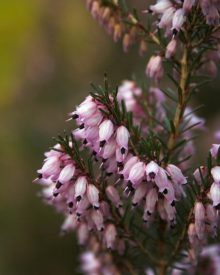 Heather is used for magick involving maturity, consummation, general luck, love, ritual power, conjuring ghosts, healing, protection, rain-making and water magick. Charms made with Heather can be worn or carried as protection against danger, rape and other violent crimes.
Heather is used for magick involving maturity, consummation, general luck, love, ritual power, conjuring ghosts, healing, protection, rain-making and water magick. Charms made with Heather can be worn or carried as protection against danger, rape and other violent crimes.
This flower represents good fortune and Heather can also be carried as a lucky charm. It was believed that wearing the blossom associated with your month of birth would bring exceptionally good luck – therefore people born in the month of Heather (August) should carry White Heather, for even better luck throughout the year.
Legend has it that a gift of white Heather brings luck to both the giver and the receiver, whereas red Heather is said to have been colored by heathens killed in battle by Christians, so is less lucky.
Heather is associated with secrets from the Otherworld. A sprig of white Heather placed in a special place of silence and meditation has the power to conjure ghosts, haints or spirits.
After picking a piece of white Heather at midnight, place it in a glass of river water in the darkest corner of your home. Sit and think of a departed loved one and it is said that the loved ones shadow will visit you.
Heather is said to ignite faery passions and open portals between their world and our own. Heather represents solitude because it thrives in wide open spaces, and Faeries who enjoy living in such undisturbed places are said to feast on the tender stalks of Heather. The Fae of this flower are drawn to humans who are shy.
Heather is useful for Solitary healing work (going within). Heather, if used along with Mistletoe, creates powerful healing medicine in both spiritual and physical aspects.
Heather can be used at Midsummer to promote love – carry red Heather for passion or white Heather for cooling the passion of unwanted suitors. If you give someone a gift of Heather it means: ‘Admiration’. A charm bag filled with Heather can be carried for decreasing egotism or self-involvement.
As a water herb, Heather is very useful in weather magick. When burned outdoors with Fern, the herbal smoke of Heather attracts rain. Bouquets of Heather and Fern can also be dipped in water to call rain.
Recommended Reading:
- Year of Moons, Season of Trees
- Tree Medicine Tree Magic
- A Druid’s Herbal
- Celtic Astrology
- Glamoury: Magic of the Celtic Green World
- The Book of Druidry
Source: dutchie.org
- Latin names: Lythrum salicaria
- Common names: Spiked loosestrife, Purple lythrum, Flowering Sally
- Gender: Feminine
- Planet: Moon
- Element: Earth
- Parts Used: Flower, leaf and stem, root
- Powers: Peace, protection
Magical Uses:
Placed in the corners of each room, this herb restores harmony and brings peace. Give to a friend to help settle an argument. Brings about protection and peaceful energies when placed in the home.
This plant was considered most powerful when gathered on the Summer Solstice. One could control demons and troublesome spirits with the root if the following words were chanted over it before a sacred image:
Tear-weed, tear-weed
You have wept long and much but gained little.
May your tears not drown the open field
Nor your cries sound over the deep blue sea.
Frighten off the demons and the witches!
If they do not submit to you,
then drown them in your tears!
If they run from your glance,
throw them over cliffs or into pits!
May my words be firm and strong
for hundreds of years!
Information collected from various sources
